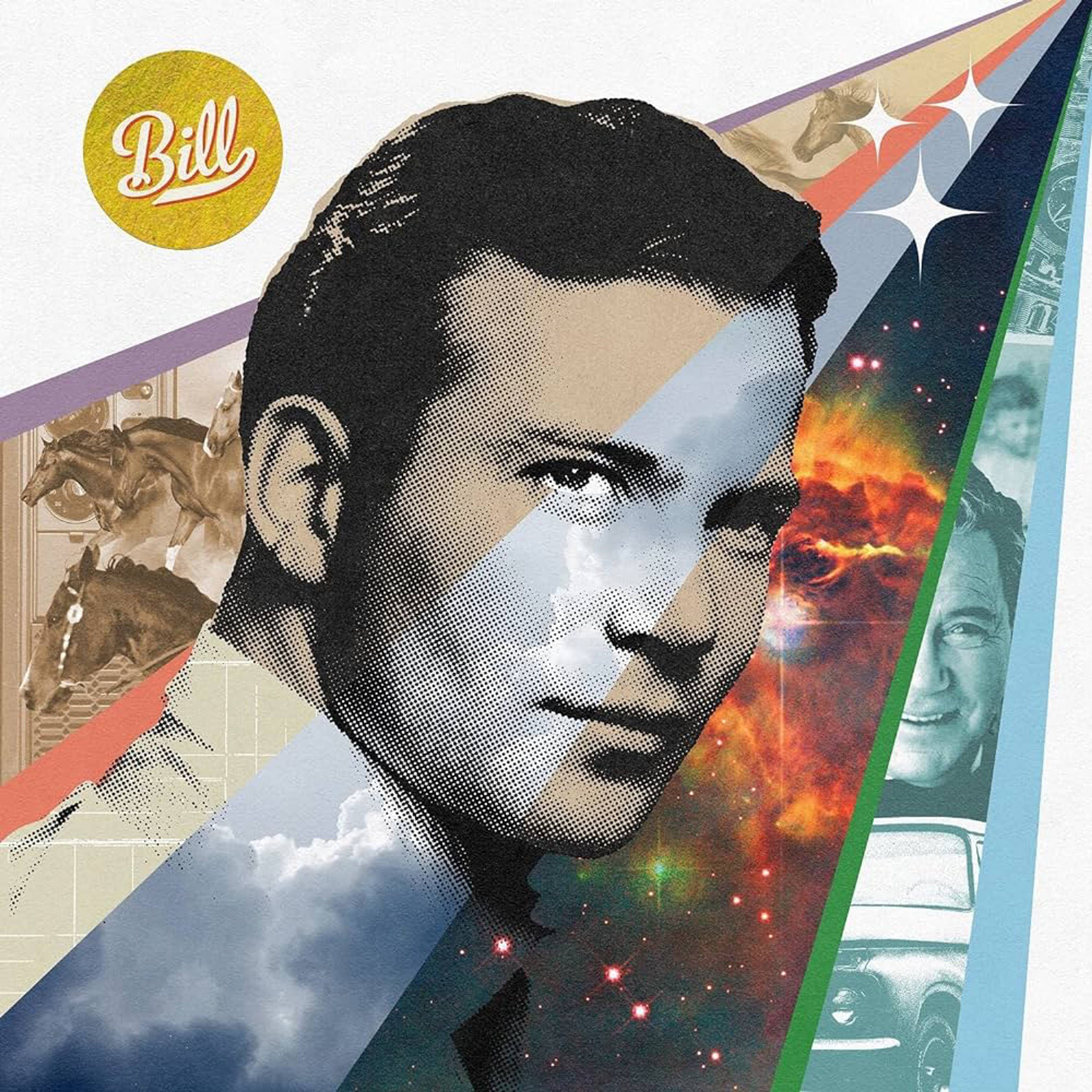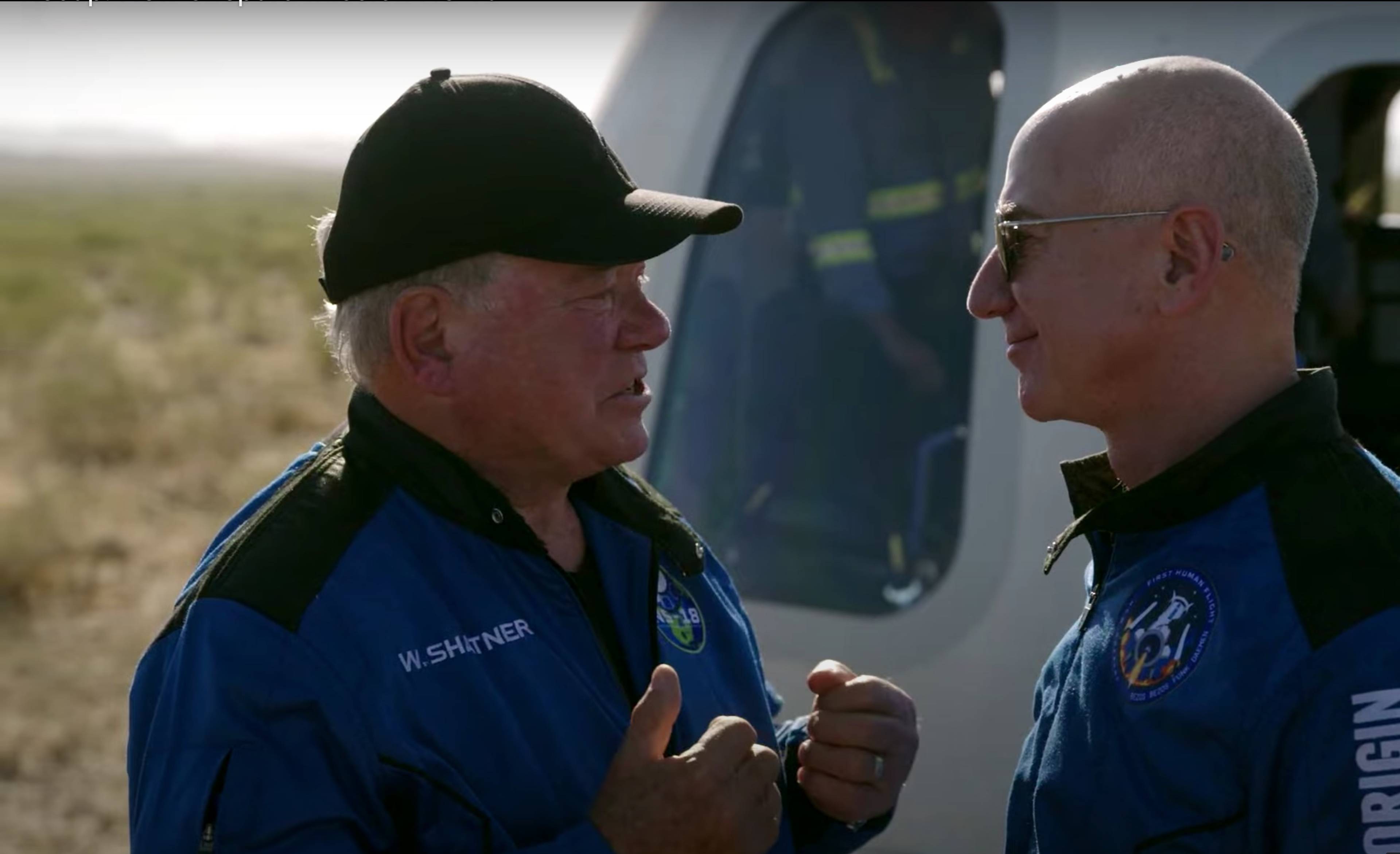William Shatner is that rare thing: an actor you can think about apart from his roles. His iconicity isn’t that of the movie star; however many movies he’s acted in (seventy some), he never became one. He is, instead, a creature of television. Following a decade of journeyman work in that medium, in the mid-60s, he rocketed to fame as Captain James T. Kirk, commander of the starship Enterprise, as part of an ensemble cast in Star Trek, a sci-fi, outer-space series that was at once earnestly ground-breaking in its socially conscious storylines; visually distinctive (all those candy-colored monochrome interiors!); and charmingly cheesy. From that launch pad, without access to genuine movie-star iconicity – you’ve either got it or you haven’t – Shatner achieved his own fame by other means. Rather than coloring within the settled lines of the Hollywood model in the manner of, say, Clint Eastwood or Cary Grant, Shatner jettisoned the cover of make believe and traveled his act around the whole of pop culture, sampling, dabbling, collaborating, hustling, and laughing all the way to the next gig. Now, the audience’s eye follows not a series of icon-modeling fictions, but the real-world adventures of the beloved William Shatner as he ping-pongs inside the system of show business.
This concept is a byproduct of Shatner’s success at role-playing, a success which delivered to him the cornucopia of opportunities that achieving modern-day show-biz celebrity can bestow. Name recognition attained, Shatner proceeded to indulge his appetite for performance (and, by implication, for attention). He stars in more TV shows and movies. He makes earnestly campy, campily earnest pop records collaborating with first-rate rock musicians (including, to give a sense of the range, 70s guitar hero Peter Frampton, country’s Vince Gill, punk’s Henry Rollins, and Britpop’s Jarvis Cocker). He co-writes sci-fi books when he’s not busy writing yet more memoirs. In TV commercials, he endorses services ranging from an internet travel agency to personal-injury attorneys. He provides voiceover for video games and animated cartoons; tours a stage act in which he relates the tales and life’s wisdom of William Shatner; and even produces a documentary of a ballet derived from his own cover of a Pulp single. On and on he goes, parkouring across the fractalicious landscape of pop commerce, in the process transcending the particulars of any one professional context.
Shatner in an ad for Commodore Computer’s Vic-20, 1982
Shatner in an ad for Kero-Sun, 1982
Shatner in an ad for the law firm Hupy and Abraham, 2014
Shatner in an ad for the travel agency Priceline
While it’s true that any ambitious show-biz personality could enter these markets, it is the actor, a professional role-player, who is in special relationship to them, able to treat every participation as yet another role. Because theater has a metaphorical relation to life – theater isn’t life, but a subset of it – any actor is, by definition, an existential symbol. Despite his annexations of the commercial realm, Shatner remains theater’s representative. An actor is sincerein the same instance that he is acting; he’s sincere about acting. As an actor who has expanded his public role-playing beyond make-believe, his presence theatricalizes every situation he’s in, rendering it at once real and a stage set. Set against the background of our commercially compromised age, and making no effort to scrub his projects free of this irony, the compromised sincerity baked into his concept reads as honesty. The stage on which he performs is American pop culture itself in the late 20th and early 21st centuries, playing William Shatner with gusto.
Success in the arts being a crapshoot – talent and drive aren’t enough, the cards must also fall just so – the avatar-concept which today attaches to Shatner was not one he could possibly have planned at the outset of what was to become a long career. Along the way, he’s gained experience with the kinds of fortuities reserved for beloved pop-culture figures in the late 20th century. The show-biz famous get to wet their beaks at a fuller banquet of capitalism than the rest of us; they’ve long enjoyed a privileged place at the table. With the late-19th-century birth of the modern advertising industry, actors, singers, and humorists started getting paid to shill – unguents, miracle elixirs, liver pills, cigarettes, Arrow shirts, booze, in time TVs, computers, and cellphone plans. A relationship that began with print ads evolved in motion pictures, radio, and, eventually, television. Actors are a natural choice to do the hawking; pretending to like or to use some product is just more acting. The promiscuity involved in a compensated endorsement is a cold, modern fact: As anyone who has seen a Godard film can tell you, sooner or later, capitalism turns us all into prostitutes. Indeed, apart from fame, the greater potential to more fully realize capitalist whorishness may just be contemporary celebrity’s defining condition. For Shatner, “saying yes” is a principle. Established within the collective synthetic experience we call the mainstream, he grazes on a seemingly infinite landscape of commercial opportunities. Ultimately, he transcends conventional iconicity altogether, forthrightly venturing into under-explored nebulae of pop fame.
Sailing through pop, Shatner’s avatar updates for the age of celebrity a familiar story about what many people think America, land of opportunity, is for.
A pop artist whose medium is opportunity, Shatner is akin to an artist working in many media – painting, drawing, sculpture – while using pop forms as his palette to produce a phenomenal range of outputs. Like his fellow creature of the 60s, Andy Warhol, Shatner had an original take on media culture – how to use it, how to move through it. Shatner, though, enjoys an ease of access to and freedom of movement within the pop-culture system that Warhol never quite won for himself, no matter the silver-haired one’s schemes and contrivances. But where Warhol could exploit the art world’s independence from show biz, Shatner is more the performing bear. With far less control over his output, it took much longer for the conceptual dimension of Shatner’s art to manifest, tended by fandom. He arrives at his art by building a monument to self-fascination from an accumulation of opportunities. (Some are rare indeed: The only feature film made in Esperanto stars Shatner.)
It isn’t just that the public life of any modern-day celebrity elicits a continual performance within constraints imposed by the marketplace, press, and audience; it’s also that certain kinds of fame, and the performances they engender, are highly fluid. Consider the mutability of a pop product such as Spiderman. What originated in a Marvel comic book became, over time, the basis for not only a movie franchise, but also Halloween costumes, children’s lunch boxes, dog onesies, and so on. Shatner intuited that the nature of his own fame, which was based not on a significant historical or scientific achievement, but on being beloved by children of all ages, made him a similarly mutable pop product, one that could take countless forms. Performance and mutability: In a sense, all Shatner did was to acknowledge the artifice that public life in the media age offers to the famous, and began proactively exploring it.
Still from William Shatner’s Gonzo Ballet, 2009, video, 60 min.
The means by which he does this is profoundly simple. He says yes, as much an assimilationist credo as Warhol’s “business art.” His enthusiastic adoption may be an expression of Shatner’s dual outsider status within American society, as a Jew and as a Canadian. First, to succeed; then, to display the success found within the hyper-capitalism of his adopted homeland – has this not been a part of the immigrant tradition from the country’s inception? Sailing through pop, Shatner’s avatar updates for the age of celebrity a familiar story about what many people think America, land of opportunity, is for.
Haven’t there always been famous people? Of course. But the celebrity of today is different, because he or she reverses a traditional sequence: In the past, fame was an awarded endpoint – you made something remarkable and became famous. Now, fame is the beginning. One becomes famous, likely using social media, before using fame as a material to makes things – usually lifestyle stuff that plays to the vanity of the upwardly mobile, who also want to think themselves special. Consequently, the celebrity of today explores the link between fame and commerce differently than his or her antecedents, as a workable and usable material, such that it is not accurate to say only about celebrities that “they are the product.”
Album cover of The Transformed Man, 1968
Album cover of Bill, 2021
Album cover of Shatner Claus, 2018
Album cover of The Blues, 2020
Toward the end of the last century, to be a free-speaking “unaffiliated celebrity” with enough clout to command the world stage at will and without kowtowing was the privilege of very few – John Lennon, Michael Jackson, Madonna (pop musicians all). Today, someone without genius for anything but self-promotion can approach a similar combination of media attention and independence. During Hollywood’s golden age, an actor was constrained and controlled by studio interests. If today’s celebrity-artist (differentiated from conventional art-world celebrity) is restricted by business interests at all, it is only by whatever their own brand’s interests. They may have advisors, but no one tells them what to do.
Trying to show its superiority, the art world adopts the posture that conventional art is somehow purer. But beyond which point is Jack Smith just making Jack Smiths, or Sally Jones more Sally Joneses? Rare is the artist who does not succumb. Today’s art is corrupted on two fronts, by the marketplace and the academy, both of which seek at ever earlier points in artistic formations to program production according to their terms. Shatner may make his share of junk (what artist doesn’t?), but by changing shape and context mercurially, at least he is playing by his own rules.
Book cover of Star Trek Memories, 1993
Book cover of Up Till Now, 2008
Book cover of Live Long and..., 2018
Book cover of Spirit of the Horse, 2018
Does Shatner’s frank and cheerful embrace of entertainment from a position of authorship make him the first postmodern celebrity? Such pronouncements quickly curdle, but he certainly preceded today’s celebrity culture, crowded with Paris Hiltons, Kim Kardashians, and their glossy ilk. In an achievement befitting the captain of a starship whose mission is “to boldly go where no man has gone before,” he can be cited as a progenitor of an emergent tribe of artists who, responding to the times in which they find themselves, have correctly identified the glaring, often coarse medium of applied celebrity, used to make things no one needs. People who are in a position to probe this medium constitute a class of artist we’re not familiar with. Is it any coincidence that Shatner, Kardashian, Hilton, and Alex Israel, whose art is designed to build, refer to, and reinforce his own mystique, are all the spawn of Los Angeles, a city with narcissism in its marrow? It is a town built by artists, and art of any kind only exists through force of will. Exaggerated self-belief is a striation in LA’s bedrock, there to be built upon.
What does it all add up to? For its practitioners, a glamorous, if likely brittle, life, one imagines. For the rest of us, it’s a new species of amusement befitting our horrifying era. William Shatner is an early adopter of the medium of celebrity and a pioneer of its experimental use. His work can be included among other evidence that our sense of who is an artist, and what is a medium, and what kind of art can be made from it, is evolving, whether or not a hidebound art world acknowledges it.
William Shatner and Jeff Bezos following the landing of the spacecraft Blue Origin, 2021
___
















